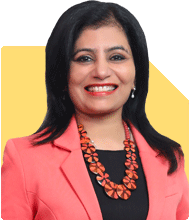Ramalingam Kalirajan |7922 Answers |Ask -Follow
Mutual Funds, Financial Planning Expert - Answered on May 18, 2024
He has an MBA in finance from the University of Madras and is a certified financial planner.
He is the director and chief financial planner at Holistic Investment, a Chennai-based firm that offers financial planning and wealth management advice.... more

I am 55 years of age and have 10 lakh in equity 2lakh in nifty and mf and 2 crore in pf. I want 2lakh post retirement
That's a fantastic question! Having Rs. 2 crore in your PF puts you in a good position for retirement. Here's how to potentially achieve your Rs. 2 lakh monthly goal:
Current Portfolio:
Strong PF Corpus: Your Rs. 2 crore PF corpus is a great foundation for retirement income.
Equity Investments: Your investments in equity and Nifty mutual funds have growth potential but also come with risk.
Estimating Retirement Income:
PF Pension: You can expect a monthly pension from your PF contributions. A CFP can help estimate the amount.
Investment Income: Your equity investments could generate income through dividends or capital appreciation. However, returns cannot be guaranteed.
Reaching the Rs. 2 Lakh Goal:
Bridging the Gap: There might be a gap between your estimated retirement income and your Rs. 2 lakh monthly goal.
Planning & Professional Guidance: Consulting a Certified Financial Planner (CFP) is recommended. They can assess your situation and suggest strategies to bridge the gap.
Potential Strategies:
Retirement Planning Tools: CFPs can use retirement planning tools to estimate your future income needs and suggest how to reach your Rs. 2 lakh goal.
Systematic Withdrawal Plan (SWP): A CFP can recommend creating an SWP from your existing investments to generate a regular income stream.
Additional Investments: They might suggest investing a portion of your equity corpus into debt funds for stability and regular income.
Remember:
Investment Horizon: Consider how long you plan to invest before needing the income. A longer horizon allows for potentially higher returns but also comes with higher risk.
Review and Adjust: Your retirement plan needs to be reviewed and adjusted periodically (at least annually) to reflect changes in your life and market conditions.
By consulting a CFP, you can create a personalized retirement plan that increases your chances of achieving your Rs. 2 lakh monthly goal!
Best Regards,
K. Ramalingam, MBA, CFP,
Chief Financial Planner,
www.holisticinvestment.in
You may like to see similar questions and answers below
Ramalingam Kalirajan |7922 Answers |Ask -Follow
Mutual Funds, Financial Planning Expert - Answered on Jul 13, 2024
Ramalingam Kalirajan |7922 Answers |Ask -Follow
Mutual Funds, Financial Planning Expert - Answered on Jun 27, 2024
Ramalingam Kalirajan |7922 Answers |Ask -Follow
Mutual Funds, Financial Planning Expert - Answered on Jul 25, 2024
Ramalingam Kalirajan |7922 Answers |Ask -Follow
Mutual Funds, Financial Planning Expert - Answered on Jul 17, 2024
Inderpaul Singh |6 Answers |Ask -Follow
Leadership Coach - Answered on Feb 10, 2025
Dr Dipankar Dutta |754 Answers |Ask -Follow
Tech Careers and Skill Development Expert - Answered on Feb 10, 2025
Ravi Mittal |526 Answers |Ask -Follow
Dating, Relationships Expert - Answered on Feb 10, 2025
Ravi Mittal |526 Answers |Ask -Follow
Dating, Relationships Expert - Answered on Feb 10, 2025
Ravi Mittal |526 Answers |Ask -Follow
Dating, Relationships Expert - Answered on Feb 10, 2025
Archana Deshpande |100 Answers |Ask -Follow
Image Coach, Soft Skills Trainer - Answered on Feb 10, 2025
Mihir Tanna |1005 Answers |Ask -Follow
Tax Expert - Answered on Feb 10, 2025
Mihir Tanna |1005 Answers |Ask -Follow
Tax Expert - Answered on Feb 10, 2025
Mihir Tanna |1005 Answers |Ask -Follow
Tax Expert - Answered on Feb 10, 2025
Mihir Tanna |1005 Answers |Ask -Follow
Tax Expert - Answered on Feb 10, 2025


























